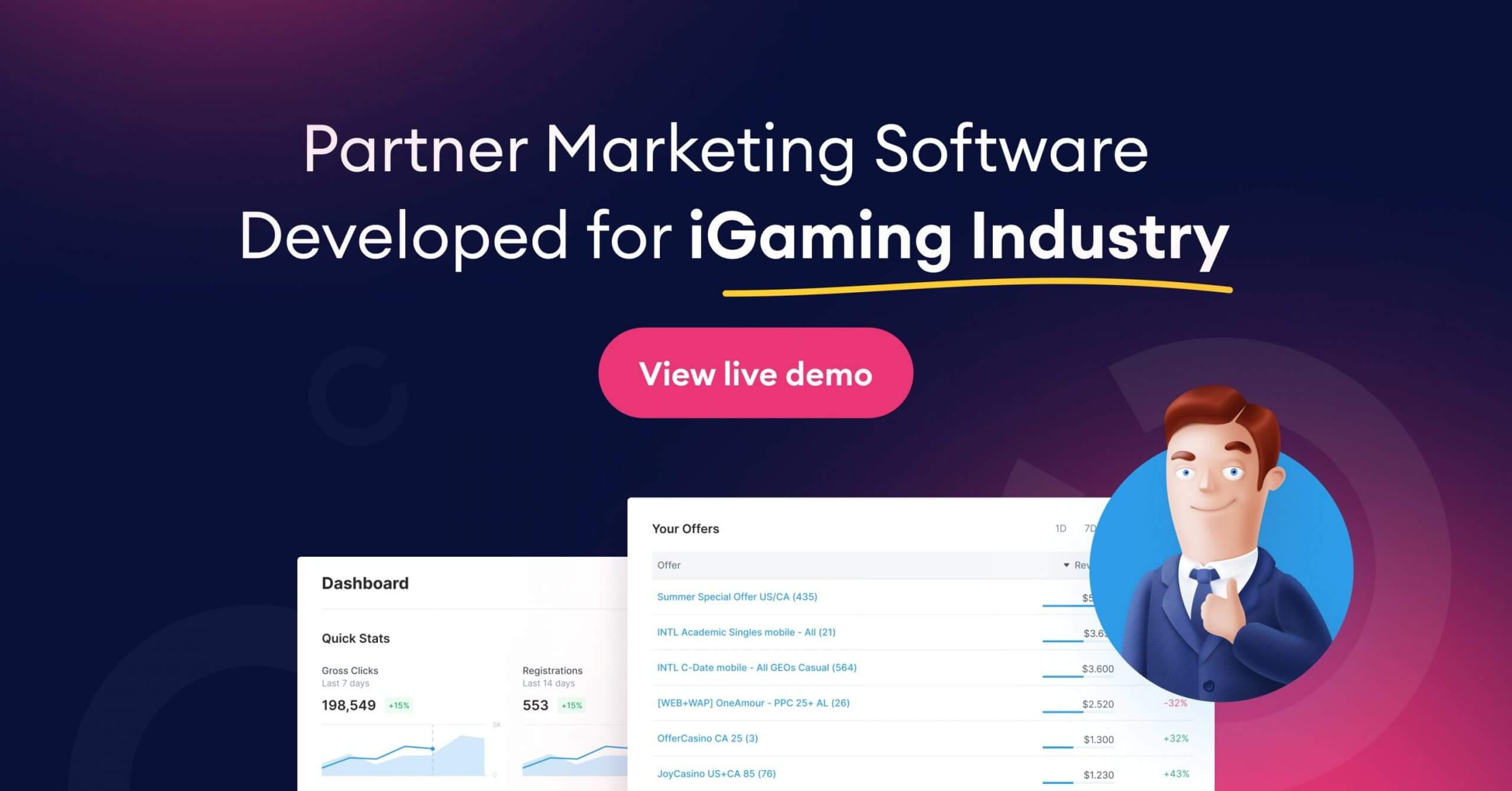Customer Lifetime Value is one of the critical metrics that not only needs to be tracked and analyzed, but also can be used to rebuild your affiliate or marketing strategy completely from scratch.
In 2024, in the competitive landscape of iGaming affiliate programs, the ability to accurately analyze Customer Lifetime Value (CLV) metrics is not merely advantageous—it’s essential. Knowing how to analyze CLV isn’t just a skill; it’s your secret weapon in maximizing profits and fine-tuning your affiliate strategies.
In this comprehensive guide, we’ll delve into the intricacies of CLV metrics, showing you how to interpret data like a pro and make decisions that keep the chips falling in your favor.
Ready to up the ante?
Let’s dive in!
What is the CLV Metric in iGaming Affiliate Programs?
Customer Lifetime Value (CLV) in iGaming affiliate programs refers to the total net profit attributed to a customer throughout their entire relationship with the platform. In the context of affiliate programs, this metric helps in understanding how much value a customer brings over time, factoring in not just initial transactions but also recurring spending on games, in-app purchases, or any other revenue-generating actions.
Metrics might include:
- Initial Deposit Amount: The first deposit made by a customer after being referred by an affiliate.
- Recurring Deposits: Subsequent deposits made over a specific time frame.
- Activity Levels: How often the customer engages with the platform (daily, weekly, monthly).
- Retention Rate: The length of time a customer remains active on the platform.
- Average Revenue Per User (ARPU): The average amount the customer spends during their lifetime.
- Churn Rate: The rate at which customers leave or cease activity.
Understanding CLV in iGaming affiliate programs is crucial for both the operators and the affiliates. It helps optimize marketing spend, tailor promotional strategies, and identify the most profitable customer segments.
Methods to Calculate Customer Lifetime Value in iGaming Affiliate Programs
LTV measures the total income a customer can generate for a casino website during their entire engagement with the site.
There are two main methods to calculate LTV in the context of iGaming affiliate programs.
1st Method: Using the Average Revenue per User (APRU) Metric
APRU is calculated by dividing the total revenue of a site by the total number of players. This calculation provides a snapshot of the average revenue generated by each player over a specific time period.
The APRU formula for CLV in iGaming Affiliate Programs can be a bit complex due to the various factors involved, but a simplified version could look like this:
CLV = (Average Value of a Conversion × Average Number of Conversions in a Time Period) × Average Customer Lifespan
Here’s a breakdown:
- Average Value of a Conversion: This is the average amount of money you earn each time a customer completes a desired action (like making a deposit).
- Average Number of Conversions in a Time Period: This is the average number of times a customer completes a conversion in a specific time frame (e.g., monthly or yearly).
- Average Customer Lifespan: This is the average time a customer remains active on the platform, often measured in months or years.
Multiply these together, and you get a simplified CLV.
For example, if your iGaming website generated total revenue of $100,000 during a specific month and had 1,000 active players, the APRU would be $100. This means that, on average, each player generated $100 in revenue during that month.
2nd Method: Through Cohort Analysis
Cohort analysis involves grouping users who made their first deposits in different months into cohorts. By analyzing the Average Revenue per User (ARPU) for each cohort, casino operators can determine the LTV for different groups of clients. This analysis helps to identify the revenue generated by different cohorts of players over their entire engagement with the site.
To perform cohort analysis, the first step is to group users based on the month they made their first deposit. This creates cohorts that represent different periods of time.
One commonly used metric in cohort analysis is the retention rate, which can be calculated as follows:
Retention Rate = (Number of users at start of period / Number of users active at end of period) × 100
Here’s a quick rundown of how you’d typically perform a cohort analysis:
- Segment Users: Divide your customer base into cohorts based on a specific characteristic or behavior, like the month they first made a purchase.
- Select Time Frame: Choose the time frame over which you’ll analyze these cohorts, such as weekly, monthly, or yearly.
- Track Metrics: For each cohort and for each time period, calculate key metrics like retention rate, churn rate, or lifetime value.
- Analyze: Compare these metrics across different cohorts to identify trends, patterns, or anomalies.
- Take Action: Use your findings to make informed decisions, like optimizing your marketing strategies or improving customer retention programs.
For example, one cohort may consist of players who made their first deposit in January, while another cohort may consist of players who made their first deposit in February.
Strategies to Increase Customer Lifetime Value in iGaming Affiliate Programs
Increasing LTV is crucial for maximizing the profitability of iGaming affiliate programs. To achieve this goal, there are several witty strategies you can implement:
Diversifying Games Offered
Why stick to the same old games when you can offer a smorgasbord of options? Diversifying the games on your iGaming website keeps players entertained and increases their engagement.
With a wide variety of slots and games, players will be hooked and stay on your site for longer periods of time. It’s like having a never-ending buffet of entertainment!
Offering Bonuses and Discounts
Everyone loves a good deal, right? Offering bonuses and discounts to your players can significantly increase their loyalty and retention. Rewards and loyalty programs are not just fancy buzzwords; they actually work!
You’ll see their lifetime value soar by incentivizing players to stay on your website or make larger deposits. It’s like giving them a secret cheat code to unlock bigger and better rewards!
Providing High-Quality Customer Support
Imagine this: you’re playing your favorite iGaming game and suddenly encounter a problem. Frustrating, isn’t it? That’s why providing top-notch customer support is crucial for increasing LTV.
A responsive and well-trained customer support team enhances the overall user experience and keeps players coming back for more. It’s like having a personal VIP assistant at their back and call.
Keeping Players Informed
Communication is key, my friend! To increase customer retention and LTV, it’s important to keep players in the know. Regularly update them about promotions, discounts, and new game releases through emails or push notifications.
You’ll maintain their interest and engagement with your site by keeping them informed. It’s like being their go-to news source for all things gaming!
These strategies are just the tip of the iceberg when it comes to boosting customer lifetime value in iGaming affiliate programs.
Real-Time Data for iGaming Affiliate Marketing
Real-time data is crucial for analyzing and improving iGaming affiliate marketing campaigns. By monitoring traffic, tracking player behavior, and conducting A/B tests, you can identify areas for improvement and optimize your marketing strategies. Leveraging analytics tools like Google Analytics and iGaming affiliate software such as Scaleo provides valuable insights into traffic, conversion rates, and other important metrics.

Real-time data also helps you personalize offers and promotions based on individual player preferences and behavior. This level of personalization enhances the player experience and increases the likelihood of continued engagement and higher customer lifetime value (LTV).
Furthermore, real-time data allows you to optimize your marketing budget by tracking the performance of different marketing channels and campaigns. By allocating resources to the most effective channels, you can maximize the return on investment and ensure that your marketing efforts are reaching the right audience.
Real-time data also plays a crucial role in fraud detection and prevention. You can flag and report fraudulent activities by monitoring player behavior and tracking suspicious activities such as multiple accounts or unusual play patterns. This protects your affiliate program and helps maintain the integrity of the iGaming industry as a whole.
Analyzing customer lifetime value metrics is essential for maximizing the profitability of iGaming affiliate programs. Calculating LTV using methods like Average Revenue per User (APRU) and cohort analysis provides valuable insights into the revenue potential of different customer segments.
Leveraging real-time data helps you make data-driven decisions, optimize marketing strategies, and detect and prevent fraud. By implementing effective strategies to increase LTV and leveraging real-time data, you can enhance your iGaming affiliate marketing campaigns and achieve long-term success in this lucrative industry.
Conclusion
Understanding and calculating the lifetime value of customers allows marketers and casino owners to make informed decisions, optimize their strategies, and drive revenue growth. CLV in betting and iGaming websites often surpasses competition due to the significant turnover of websites in these niches. Remember, that…
- Customer Lifetime Value (or LTV – lifetime value) is a key metric in iGaming affiliate programs.
- Calculation methods for CLV include Average Revenue per User (APRU) and cohort analysis.
- Diversifying games, offering bonuses, providing high-quality support, and keeping players informed are strategies to increase LTV.
- Real-time data is crucial in analyzing and optimizing iGaming affiliate marketing campaigns.
Calculating customer lifetime value is essential for both marketers and casino owners. Marketers can optimize their investments and determine the potential income per user over a specific time period. This information allows for effective resource allocation and data-driven decision-making to maximize return on investment.
Casino owners benefit from knowing CLV as it helps them understand their operations’ profitability. By studying each customer’s income and expenses, they can make informed decisions on marketing budgets, customer acquisition costs, and revenue generation.
Analyzing Customer Lifetime Value is not just about numbers; it’s about using those numbers to gain valuable insights that fuel business growth. With this knowledge, you can successfully navigate the complexities of the iGaming affiliate world, creating long-term relationships with customers that benefit everyone involved.
Ready to take your CLV analysis to the next level?
Scaleo’s cutting-edge affiliate software offers robust analytics features designed to help you accurately measure and optimize Customer Lifetime Value. Don’t just rely on guesswork; use data-driven insights to make informed decisions that propel your iGaming affiliate program to new heights.

Last Updated on April 16, 2024





